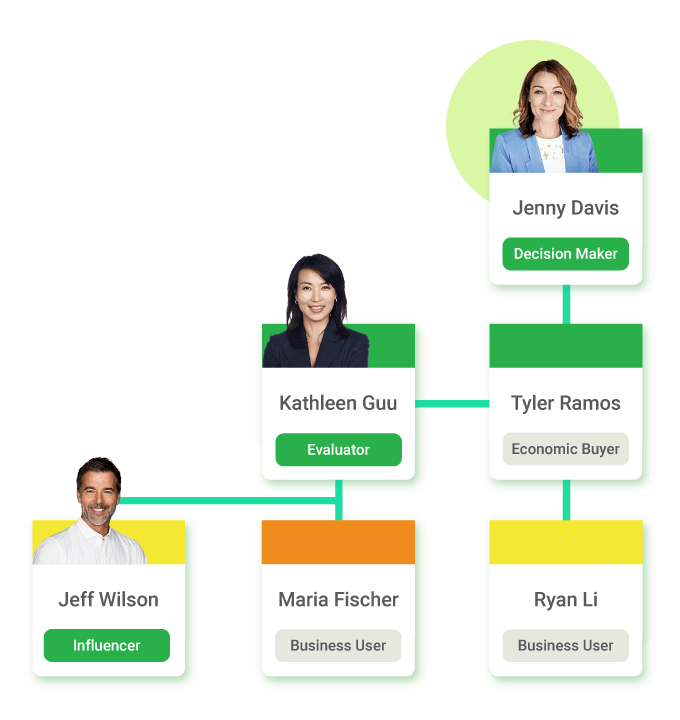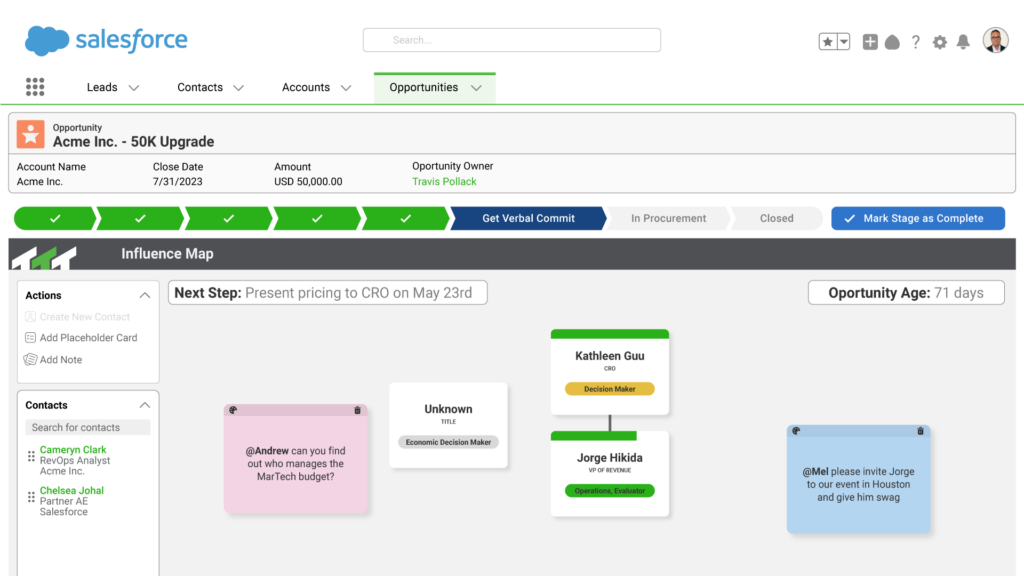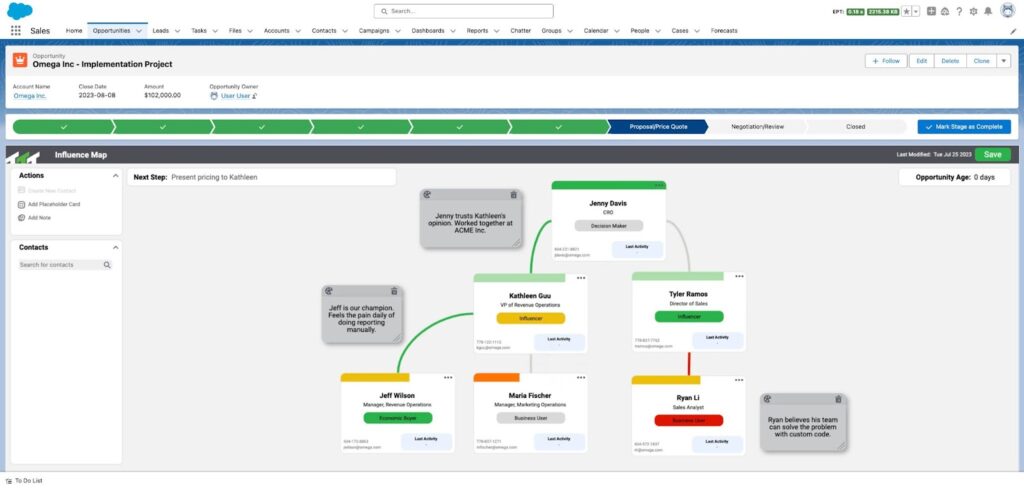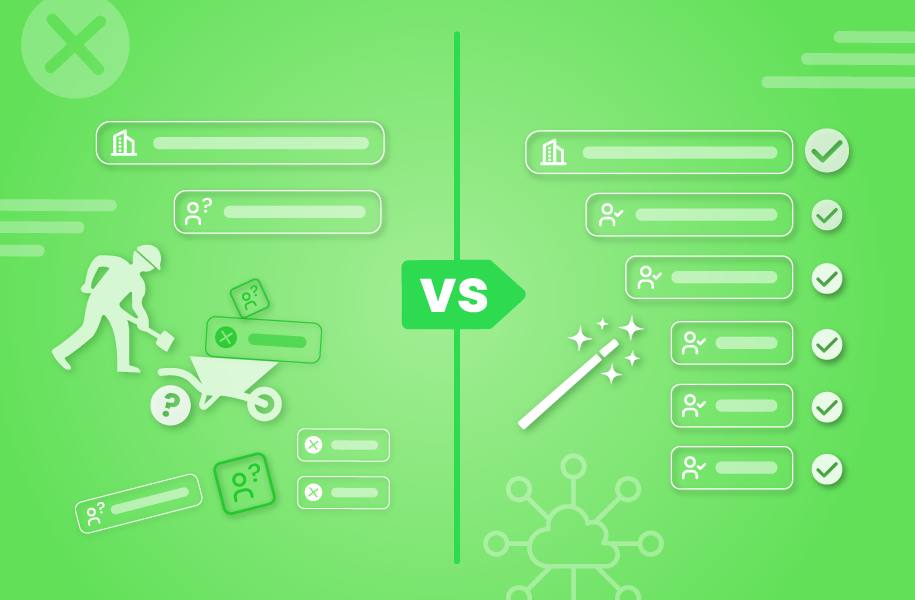Introduction
It’s harder than ever for organizations to navigate the complex and growing number of stakeholders in B2B purchases.
On top of that, sales teams are losing deals or taking too long to close because they aren’t building relationships with the people who can help them win.
As a sales leader, it’s difficult to help your sales reps strategize, review, and navigate these deals – and a big reason is that you’re spending more time trying to understand where the opportunity is at, rather than focusing on the strategy and execution that will help close the deal.
Here are the steps that you can take to run the best deal reviews with your sales team and improve your win rates.
You might also like:
- 3 Salesforce sales processes stopping you from selling more
- How does a relationship map help B2B sales teams close more deals?
- 4 ways to improve the marketing to sales lead handoff
5 steps to improve your deal reviews
Review accounts with sales reps once accounts are assigned
Setting up your sales reps for success before deal reviews are underway is crucial.
Once territories are set and a sales rep has their accounts, it’s time for them to do their homework.
As a sales manager, conducting account reviews creates an opportunity to provide feedback, share your point of view, and start a collaborative process on how different accounts can be approached.
It also encourages sales reps to dig into Salesforce and learn the historical activity of their accounts, the most recent activities, and build an understanding of what needs to be prioritized within their sales territory and different accounts.
This is also a starting block for them to build a relationship map and outline the playing fields within each company. With the complexity of B2B software purchases increasing, sales reps need to identify and engage with the key players within an account – and the earlier they know who those individuals are, the better.

Titles can be deceiving. Understanding who holds influence within an account, whether on a functional level like a CFO or a technical level like a CTO, is important for navigating the complexities of B2B purchases.
Restructure your deal reviews (focus on strategy, not updates)
Sales leaders have anywhere from a few to dozens of sales reps under them, each working on many deals with multiple stakeholders.
When it comes to mentoring sales reps and reviewing deals, managers need immediate visibility into the details of opportunities – that way, they spend more time providing coaching and insight, and less time trying to catch up and understand how a deal has progressed.
To do this, sales teams at Salesforce consistently have three slide assets they review that are always kept up to date and used for deal reviews:
- Vision – what is the long-term goal for the customer?
- Deal review – what is the status of the opportunity and immediate next steps?
- Relationship map – who’s who, and what is your strategy for multi-threading?
The vision describes the sales reps’ future goals for the customer and how they plan to help them get there. Like when managers review accounts individually with sales reps, this asset requires research, doing homework to understand the client, and creative thinking around how the sales rep can uniquely help the customer solve that problem.
It also calls for an understanding of what problems the customer is dealing with, how to respond to and solve the company’s problems, and what the future roadmap looks like.
The deal review contains the basic mechanics of the deal, close plans, and how the sales rep intends to get there. This asset also needs to include details such as what products and services are being offered, and how far in the sales cycle the deal is.
The third asset, the relationship map, is perhaps the most important when it comes to being able to multi-thread deals. This map outlines who the stakeholders and champions are, when the last connect was with them, and what steps are needed to turn blockers into champions.

Operationalize multithreading in your deal reviews
According to LinkedIn, only 22% of sales reps multi-thread their deals – that’s one in every five people.
But it was also found that those who multi-thread their deals see a 34% increase in win rate versus sales reps that single-thread their deals.
The bottom line? You’re killing your win rates by not leveraging the multiple champions (and navigating the blockers) involved in an opportunity.
But as a sales manager, how do you encourage your sales reps to multi-thread their deals?
In addition to making relationship maps a frequent part of the review process, it’s important to understand that, in many cases, multi-threading is a new muscle for most sales reps. And like starting a new workout routine or picking up a new hobby, it’s a habit that builds up over time.
Here’s some starter tips:
- Ask initial contacts for additional contacts early (once you build relationships, it can be hard to go over their head)
- Connect like titles and bring in your team (most people like to talk to their equals and equals have more weight)
- For enterprise selling, start with subsidiaries and work your way up the ladder. bridge the gap between departments first and then work your way to other subsidiaries and up the ladder
Greg Micklos, Manager of GTM Readiness Programs at Salesforce, suggests finding ways to make it fun – like incentivizing it through a contest or spiff program.
“Spend a quarter or two building the muscle memory, he explains in a RevGenius webinar. “If you come in with the whip, you’re not going to get the reaction or activity that you’re looking for.”
He also suggests that sales managers encourage their sales reps to be curious and bring out their inner child.
“By just the natural course of having those conversations, you open the door to new relationships, new stakeholders, additional budget to chip in, a new set of people who might benefit from it, and new licenses.”
Ensure important information is living in Salesforce (and nowhere else)
When the important information surrounding a deal is scattered and doesn’t live inside your CRM, it becomes harder to uncover and replicate the trends and activity that are leading to deals closing.
Ultimately, it creates more work for sales reps, sales leaders when it comes to deal reviews, and even members of the go-to-market team like marketing and customer success. That’s why Google Docs, Notion, Quip, and even an org chart won’t cut it.

On top of that, what happens when a sales rep leaves a company and a new one comes in? Unless the previous sales rep’s notes are well written and available somewhere that everyone can access, the new rep be left starting from scratch.
The same applies to when your sales team undergoes a territory change, a rep goes on vacation, or a sales manager or executive needs a quick understanding of the landscape of a deal.
As a sales manager, another way to encourage the use of relationship mapping is to automate as much of the process as you can.
“Sales reps love talking to people — they don’t love entering data. You want to be capturing the conversations that they’re having, you want to be adding those records into your CRM instead of having to do it manually.”
-David Nelson, CEO, Traction Complete
Share learning with wider team and between stakeholders
As a sales leader, your having multiple deal reviews with multiple reps. This learning is often lost between notes and 1-1 conversations, whereas you could be helping the entire team learn and grow together.
When a sales rep runs into larger opportunities with multiple stakeholders involved, it’s an excellent opportunity to share those learnings and run larger reviews amongst the wider sales team.
Factors like the number of decision-makers in a deal and their positions, look different with every company. These bigger deal reviews create an opportunity for sales managers to dig in and explore that landscape. If you use a relationship map, you can focus less time on updates and more time on strategy and sharing tactics for multi-threading.
It also encourages sales reps to regularly update and maintain their relationship maps, transforming them into a living document – especially with active opportunities.
The goal is simple. When it comes to a company that isn’t involved in an active opportunity, sales reps may not see the urgency in updating that relationship map. But when it comes to an ongoing opportunity, constant updates ensure that the relationship map will reflect the current state of affairs, the champions and blockers, and how they interact.
Conclusion
By understanding the vision behind different accounts, the champions, blockers, and politics in play, and how sales reps plan to close different deals, sales leaders can help their team stay focused with smarter, strategic helping.
Keeping a relationship map up-to-date through the year will ensure that sales leaders can provide valuable coaching and guidance to sales reps, rather than wasting time trying to understand where an opportunity is at.





